brake KIA CARENS RHD 2018 Owners Manual
[x] Cancel search | Manufacturer: KIA, Model Year: 2018, Model line: CARENS RHD, Model: KIA CARENS RHD 2018Pages: 723, PDF Size: 40.94 MB
Page 10 of 723
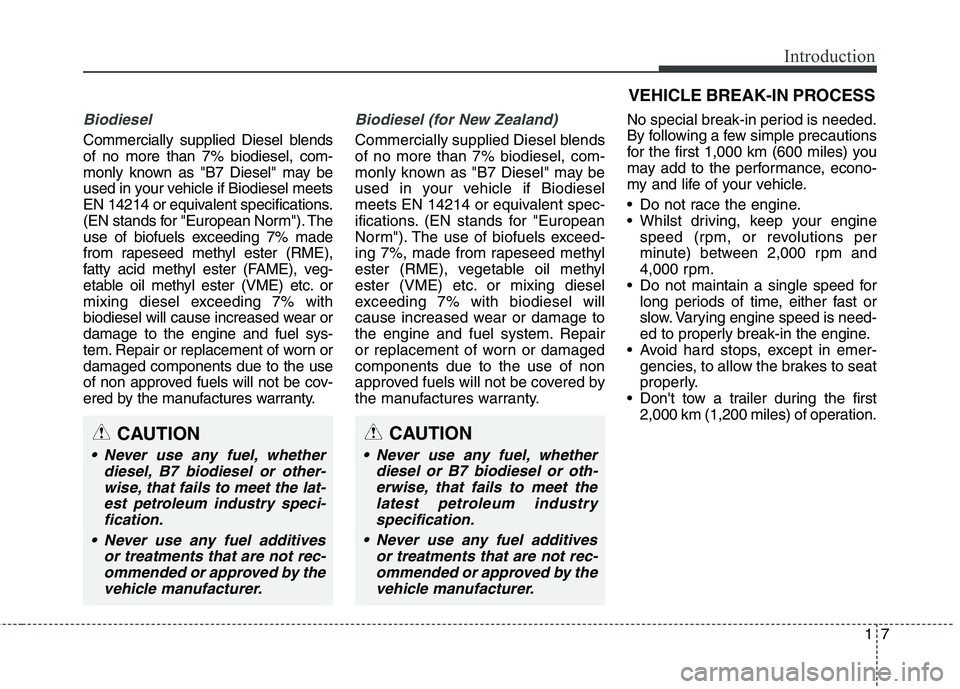
17
Introduction
Biodiesel
Commercially supplied Diesel blends of no more than 7% biodiesel, com-
monly known as "B7 Diesel" may be
used in your vehicle if Biodiesel meets
EN 14214 or equivalent specifications.
(EN stands for "European Norm"). The
use of biofuels exceeding 7% made
from rapeseed methyl ester (RME),
fatty acid methyl ester (FAME), veg-
etable oil methyl ester (VME) etc. or
mixing diesel exceeding 7% with
biodiesel will cause increased wear ordamage to the engine and fuel sys-
tem. Repair or replacement of worn ordamaged components due to the use
of non approved fuels will not be cov-
ered by the manufactures warranty.
Biodiesel (for New Zealand)
Commercially supplied Diesel blends of no more than 7% biodiesel, com-
monly known as "B7 Diesel" may be
used in your vehicle if Biodiesel
meets EN 14214 or equivalent spec-
ifications. (EN stands for "European
Norm"). The use of biofuels exceed-
ing 7%, made from rapeseed methyl
ester (RME), vegetable oil methyl
ester (VME) etc. or mixing diesel
exceeding 7% with biodiesel will
cause increased wear or damage to
the engine and fuel system. Repair
or replacement of worn or damagedcomponents due to the use of non
approved fuels will not be covered by
the manufactures warranty.No special break-in period is needed.
By following a few simple precautions
for the first 1,000 km (600 miles) you
may add to the performance, econo-
my and life of your vehicle.
Do not race the engine.
Whilst driving, keep your engine
speed (rpm, or revolutions per
minute) between 2,000 rpm and
4,000 rpm.
Do not maintain a single speed for long periods of time, either fast or
slow. Varying engine speed is need-
ed to properly break-in the engine.
Avoid hard stops, except in emer- gencies, to allow the brakes to seat
properly.
Don't tow a trailer during the first 2,000 km (1,200 miles) of operation.
CAUTION
Never use any fuel, whether
diesel, B7 biodiesel or other-wise, that fails to meet the lat-est petroleum industry speci-fication.
Never use any fuel additives or treatments that are not rec-ommended or approved by thevehicle manufacturer.
CAUTION
Never use any fuel, whether diesel or B7 biodiesel or oth-erwise, that fails to meet the latest petroleum industryspecification.
Never use any fuel additives or treatments that are not rec-ommended or approved by the vehicle manufacturer.
VEHICLE BREAK-IN PROCESS
Page 16 of 723
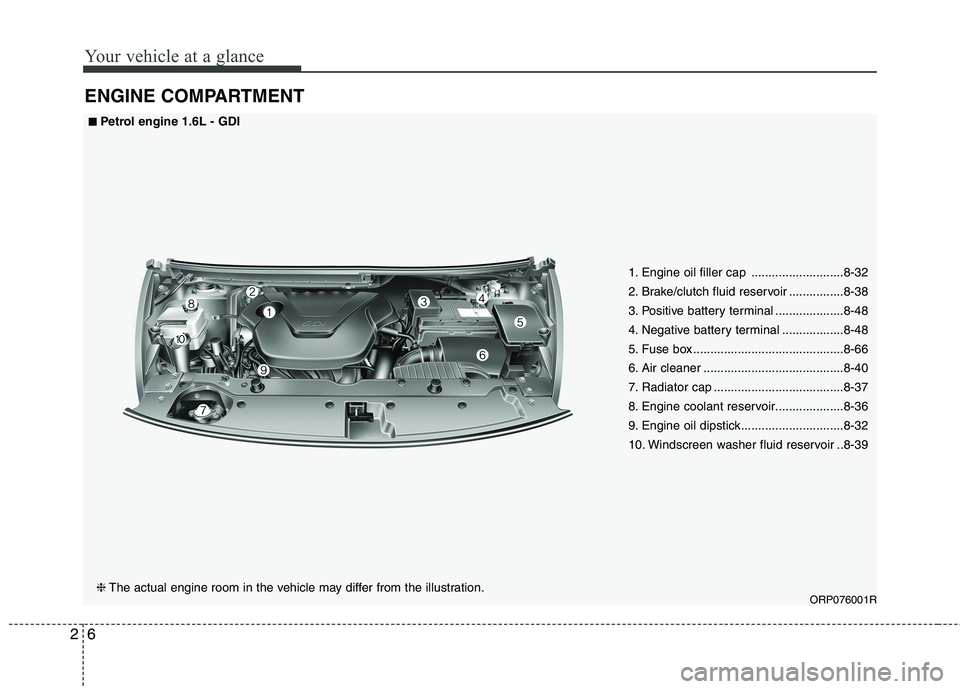
Your vehicle at a glance
6
2
ENGINE COMPARTMENT
ORP076001R
■■
Petrol engine 1.6L - GDI
❈ The actual engine room in the vehicle may differ from the illustration. 1. Engine oil filler cap ...........................8-32
2. Brake/clutch fluid reservoir ................8-38
3. Positive battery terminal ....................8-48
4. Negative battery terminal ..................8-48
5. Fuse box ............................................8-66
6. Air cleaner .........................................8-40
7. Radiator cap ......................................8-37
8. Engine coolant reservoir....................8-36
9. Engine oil dipstick..............................8-32
10. Windscreen washer fluid reservoir ..8-39
Page 17 of 723
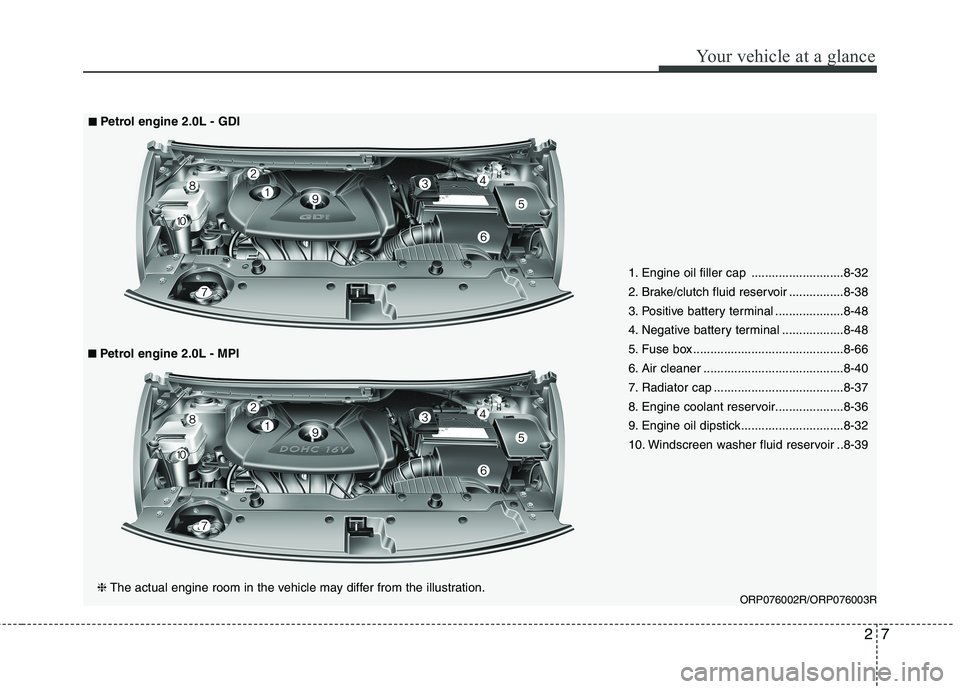
27
Your vehicle at a glance
1. Engine oil filler cap ...........................8-32
2. Brake/clutch fluid reservoir ................8-38
3. Positive battery terminal ....................8-48
4. Negative battery terminal ..................8-48
5. Fuse box ............................................8-66
6. Air cleaner .........................................8-40
7. Radiator cap ......................................8-37
8. Engine coolant reservoir....................8-36
9. Engine oil dipstick..............................8-32
10. Windscreen washer fluid reservoir ..8-39ORP076002R/ORP076003R
■■Petrol engine 2.0L - MPI
❈ The actual engine room in the vehicle may differ from the illustration.
■■
Petrol engine 2.0L - GDI
Page 18 of 723
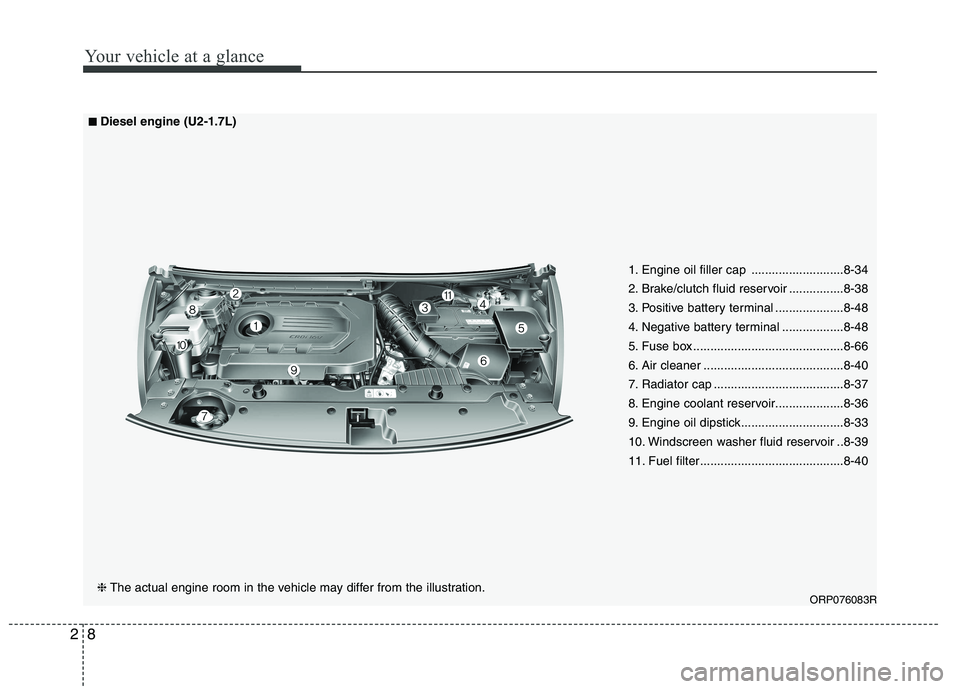
Your vehicle at a glance
8
2
1. Engine oil filler cap ...........................8-34
2. Brake/clutch fluid reservoir ................8-38
3. Positive battery terminal ....................8-48
4. Negative battery terminal ..................8-48
5. Fuse box ............................................8-66
6. Air cleaner .........................................8-40
7. Radiator cap ......................................8-37
8. Engine coolant reservoir....................8-36
9. Engine oil dipstick..............................8-33
10. Windscreen washer fluid reservoir ..8-39
11. Fuel filter..........................................8-40
ORP076083R
❈
The actual engine room in the vehicle may differ from the illustration.
■■
Diesel engine (U2-1.7L)
Page 37 of 723
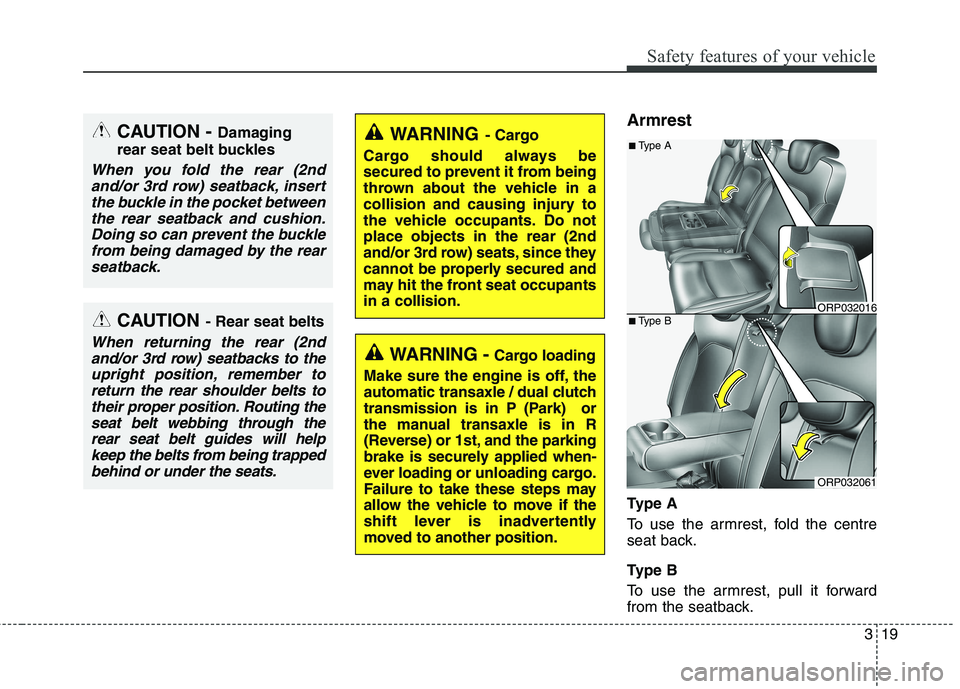
319
Safety features of your vehicle
Armrest
Ty p e A
To use the armrest, fold the centre
seat back.
Ty p e B
To use the armrest, pull it forward
from the seatback.
CAUTION- Rear seat belts
When returning the rear (2nd
and/or 3rd row) seatbacks to theupright position, remember to return the rear shoulder belts totheir proper position. Routing theseat belt webbing through the rear seat belt guides will helpkeep the belts from being trappedbehind or under the seats.
CAUTION - Damaging
rear seat belt buckles
When you fold the rear (2nd and/or 3rd row) seatback, insertthe buckle in the pocket between the rear seatback and cushion.Doing so can prevent the bucklefrom being damaged by the rear seatback.
WARNING - Cargo
Cargo should always be
secured to prevent it from being
thrown about the vehicle in a
collision and causing injury to
the vehicle occupants. Do notplace objects in the rear (2nd
and/or 3rd row) seats, since they
cannot be properly secured and
may hit the front seat occupantsin a collision.
WARNING - Cargo loading
Make sure the engine is off, the
automatic transaxle / dual clutch
transmission is in P (Park) or
the manual transaxle is in R
(Reverse) or 1st, and the parking
brake is securely applied when-
ever loading or unloading cargo.
Failure to take these steps may
allow the vehicle to move if the
shift lever is inadvertently
moved to another position.
ORP032061
ORP032016
■ Type A
■Type B
Page 93 of 723
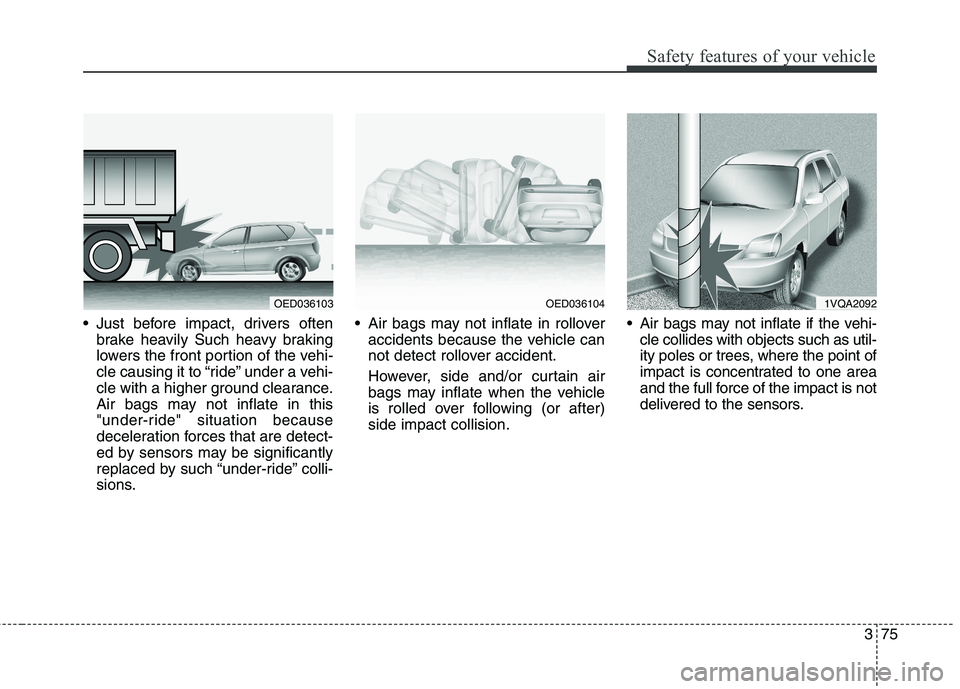
375
Safety features of your vehicle
Just before impact, drivers oftenbrake heavily Such heavy braking
lowers the front portion of the vehi-
cle causing it to “ride” under a vehi-
cle with a higher ground clearance.
Air bags may not inflate in this
"under-ride" situation because
deceleration forces that are detect-
ed by sensors may be significantly
replaced by such “under-ride” colli-
sions. Air bags may not inflate in rollover
accidents because the vehicle can
not detect rollover accident.
However, side and/or curtain air
bags may inflate when the vehicle
is rolled over following (or after)side impact collision. Air bags may not inflate if the vehi-
cle collides with objects such as util-
ity poles or trees, where the point of
impact is concentrated to one area
and the full force of the impact is not
delivered to the sensors.
OED036103OED0361041VQA2092
Page 123 of 723
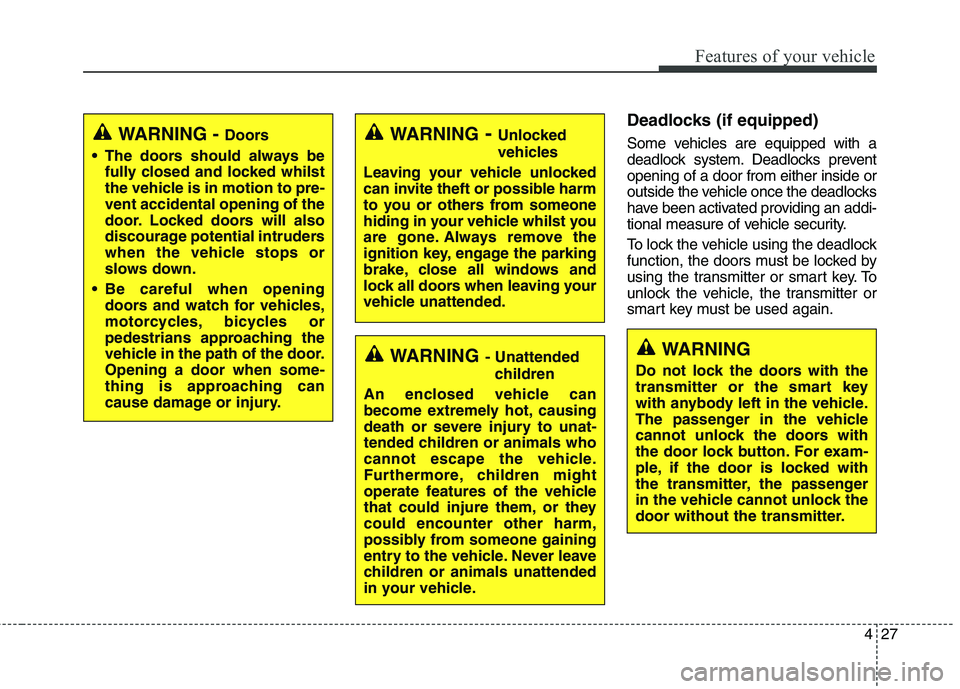
427
Features of your vehicle
Deadlocks (if equipped)
Some vehicles are equipped with a
deadlock system. Deadlocks preventopening of a door from either inside or
outside the vehicle once the deadlocks
have been activated providing an addi-
tional measure of vehicle security.
To lock the vehicle using the deadlock
function, the doors must be locked by
using the transmitter or smart key. To
unlock the vehicle, the transmitter or
smart key must be used again.WARNING - Doors
The doors should always be fully closed and locked whilst
the vehicle is in motion to pre-vent accidental opening of the
door. Locked doors will also
discourage potential intruders
when the vehicle stops or
slows down.
Be careful when opening doors and watch for vehicles,
motorcycles, bicycles or
pedestrians approaching the
vehicle in the path of the door.Opening a door when some-
thing is approaching can
cause damage or injury.WARNING - Unlocked
vehicles
Leaving your vehicle unlocked
can invite theft or possible harm
to you or others from someone
hiding in your vehicle whilst you
are gone. Always remove the
ignition key, engage the parking
brake, close all windows and
lock all doors when leaving your
vehicle unattended.
WARNING - Unattended
children
An enclosed vehicle can
become extremely hot, causing
death or severe injury to unat-
tended children or animals who
cannot escape the vehicle.
Furthermore, children might
operate features of the vehicle
that could injure them, or theycould encounter other harm,
possibly from someone gaining
entry to the vehicle. Never leave
children or animals unattended
in your vehicle.WARNING
Do not lock the doors with the
transmitter or the smart key
with anybody left in the vehicle.
The passenger in the vehicle
cannot unlock the doors with
the door lock button. For exam-
ple, if the door is locked with
the transmitter, the passenger
in the vehicle cannot unlock the
door without the transmitter.
Page 134 of 723

Features of your vehicle
38
4
Opening the bonnet
1. Pull the release lever to unlatch
the bonnet. The bonnet should
pop open slightly. 2. Go to the front of the vehicle, raise
the bonnet slightly, pull up the sec-
ondary latch (1) inside of the bon-net centre and lift the bonnet (2). 3. Pull out the support rod.
4. Hold the bonnet opened with the
support rod.
BONNET
ORP042015R
WARNING
Open the bonnet after turning off
the engine on a flat surface,
shifting the shift lever to the
P(Park) position for automatic
transaxle / dual clutch transmis-
sion and to the 1(First) gear or
R(Reverse) for manual transaxle,
and setting the parking brake.
WARNING - Hot parts
Be very careful not to touch the
support rod when the engine
and parts are hot. You could get
burned or get seriously injured.
ORP046016LORP042017
Page 165 of 723

469
Features of your vehicle
Service in OFF
If the service interval is not set,
“Service in OFF” message is dis-
played on the LCD display (for type A).
✽✽NOTICE
If any of the following conditions
occurs, the mileage and days may be
incorrect.
- The battery cable is disconnected.
- The fuse switch is turned off.
- The battery is discharged.
User Settings Mode
Description
On this mode, you can change set-
ting of the doors, lamps, and so on.
Edit settings after shifting to P/Edit set-
tings after engaging parking brake
This warning message appears if
you try to adjust the User Settings
whilst driving.
- Automatic transaxle/Dual clutch transmission
For your safety, change the User
Settings after parking the vehicle,
applying the parking brake and
moving the shift lever to P (Park).
- Manual transaxle For your safety, change the User
Settings after engaging the parking
brake.
ORP046315L
ORP046317L
WARNING
Do not adjust the User Setting
whilst driving. You may lose
your steering control and cause
severe personal injury or acci-dents.
Page 168 of 723
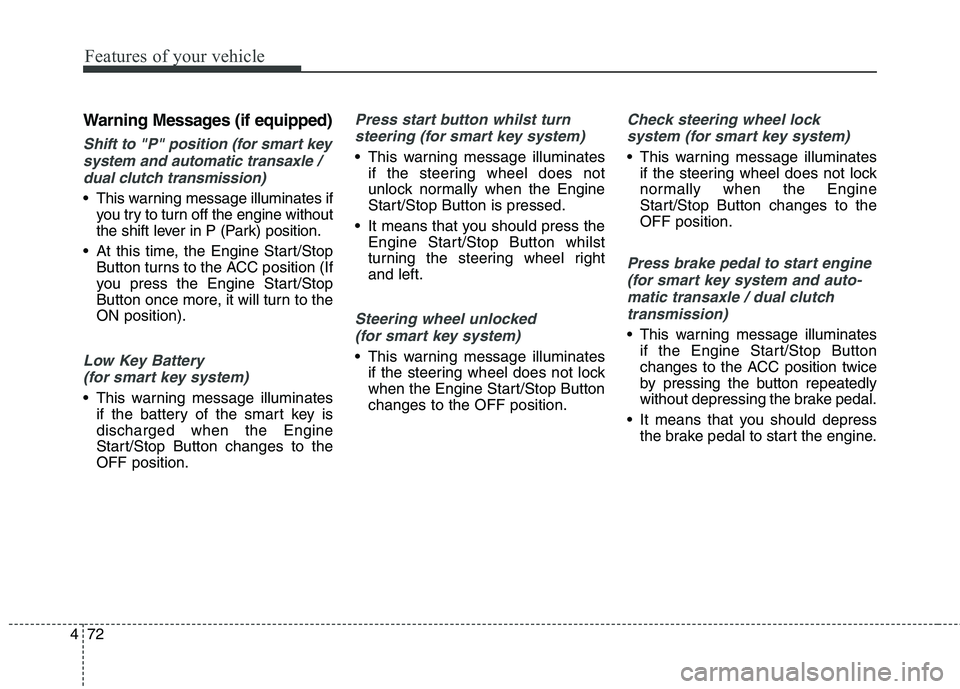
Features of your vehicle
72
4
Warning Messages (if equipped)
Shift to "P" position (for smart key
system and automatic transaxle / dual clutch transmission)
This warning message illuminates if you try to turn off the engine without
the shift lever in P (Park) position.
At this time, the Engine Start/Stop Button turns to the ACC position (If
you press the Engine Start/Stop
Button once more, it will turn to theON position).
Low Key Battery
(for smart key system)
This warning message illuminates if the battery of the smart key is discharged when the Engine
Start/Stop Button changes to theOFF position.
Press start button whilst turn
steering (for smart key system)
This warning message illuminates if the steering wheel does not
unlock normally when the Engine
Start/Stop Button is pressed.
It means that you should press the Engine Start/Stop Button whilst
turning the steering wheel rightand left.
Steering wheel unlocked
(for smart key system)
This warning message illuminates if the steering wheel does not lock
when the Engine Start/Stop Buttonchanges to the OFF position.
Check steering wheel lock
system (for smart key system)
This warning message illuminates if the steering wheel does not lock
normally when the Engine
Start/Stop Button changes to theOFF position.
Press brake pedal to start engine
(for smart key system and auto- matic transaxle / dual clutchtransmission)
This warning message illuminates if the Engine Start/Stop Button
changes to the ACC position twice
by pressing the button repeatedly
without depressing the brake pedal.
It means that you should depress the brake pedal to start the engine.